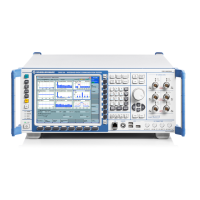Remote Control
R&S
®
CMW500
186User Manual 1173.9463.02 ─ 06
Query_macro 1 GHz
FETCh:BASE:BUFFer:LINEcount? 'Frequency_Buffer'
// Re-activate the buffer to appended further lines.
// The line count query returns 4.
CONTinue:BASE:BUFFer 'Frequency_Buffer'
Query_macro 4 GHz
STOP:BASE:BUFFer
FETCh:BASE:BUFFer:LINEcount? 'Frequency_Buffer'
// Clear the buffer contents: the line count query returns 0
// Delete the buffer: the line count query times out and the error queue
// contains an entry with code -273 "Illegal macro label"
CLEAR:BASE:BUFFer 'Frequency_Buffer'
FETCh:BASE:BUFFer:LINEcount? 'Frequency_Buffer'
DELete:BASE:BUFFer 'Frequency_Buffer'
FETCh:BASE:BUFFer:LINEcount? 'Frequency_Buffer'
SYSTem:ERRor?
5.9 LXI Configuration
LAN eXtensions for Instrumentation (LXI) is an instrumentation platform for measuring
instruments and test systems that is based on standard Ethernet technology. LXI is
intended to be the LAN-based successor to GPIB, combining the advantages of Ethernet
with the simplicity and familiarity of GPIB.
5.9.1 LXI Classes and LXI Functionality
LXI-compliant instruments are divided into three classes, A, B and C, with the functionality
of the classes hierarchically based one upon the other:
●
Class C instruments are characterized by a common LAN implementation, including
an ICMP ping responder for diagnostics, see Ping Client.
LXI Configuration

